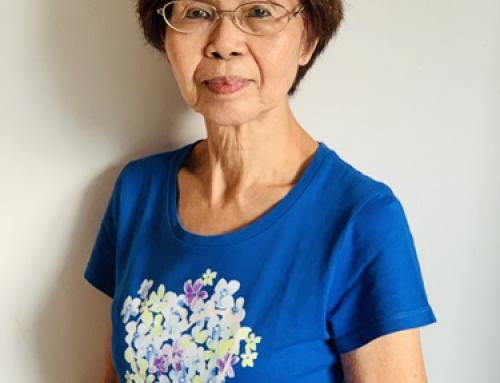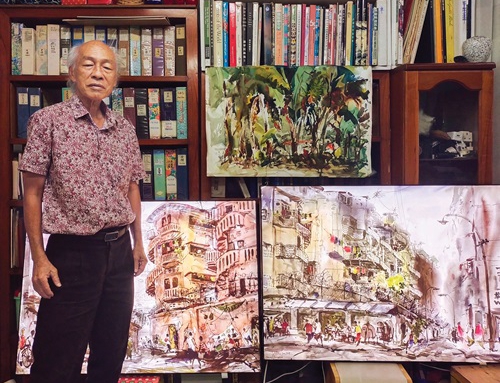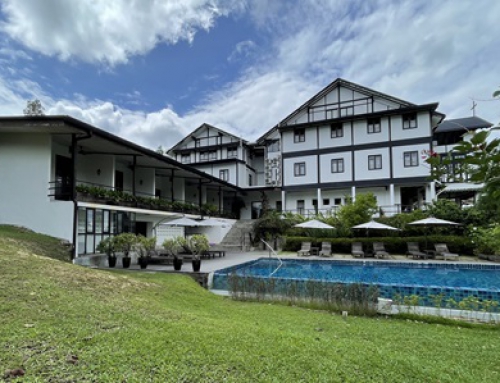古典印度舞
文 · 吴明珠 图 · Singapore Indian Fine Arts Society, Bhaskar’s Arts Academy
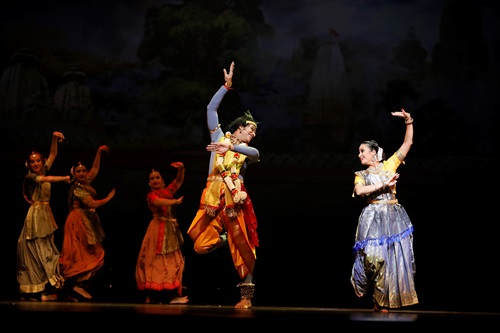
《舞蹈历程》剧照
印度族是我国的四大民族之一,他们的传统艺术在新加坡这一块土地上得以保留和传承。2019年4月中在滨海艺术中心音乐厅举行的《舞蹈的历程》(Natya Yatra)就全面地展现了印度古典舞蹈的勃勃生机。
《舞蹈的历程》是Singapore Indian Fine Arts Society (SIFAS) 为庆祝成立70周年,特与滨海艺术中心合作的演出,该演出也是艺术学院第17届的古典印度音乐舞蹈节的节目之一。长达3个小时的《舞蹈的历程》以古典舞蹈、纪录片、动画、旁述以及现场乐队来介绍百年来古典印度舞在我国的发展情况。其他参加演出的艺术团体包括 Apsaras Art, Temple of Fine Arts, Bhaskar’s Arts Academy以及Usha Rani Maniam Dance School。
古典印度舞种类繁多,其中4种在新加坡有不少学生。这4大类是:Bharatanathyam, Kuchipudi,Kathak和Kathakali。它们在远古时期盛行于印度庙和宫廷,表演者原来只有男性,后来许多女性也加入这个行业。Bharatanathyam, Kuchipudi和Kathakali是南印度的艺术,唯有Kathak属于北方的舞蹈。
由于我国的印度同胞大部分是南印度淡米尔纳都和周边省份印度人的后裔,因此学习Bharatanathyam的人数最多。
Bharatanathyam 以屈膝功夫著称
Bharatanathyam 舞蹈动作分抽象和写实两种。抽象的部分着重几何图形的姿势,以屈膝的功夫为特征。写实的部分叙述兴都教的神话传说或文学作品的片段,有南印度古典歌曲伴唱。
参与《舞蹈的历程》演出及编舞的Bharatanathyam老师吉塔纳丹(39岁)是印度著名的卡拉斯特拉舞蹈学院的毕业生,曾在印度、马来西亚、中国、日本和东南亚各国表演。吉塔纳丹对《舞蹈的历程》有美好的印象。他说:“参加这一个演出让我了解古典印度舞在新加坡的起源,发展及展望。看到我们珍贵的文化在这里开花结果,我非常欣慰。还有,我发现新加坡的观众很懂得欣赏古典舞,这是一个很好的现象。”
Kuchipudi 有民俗趣味
Kuchipudi 和 Bharatanathyam 在舞蹈技术上很靠近,唯一的差别是: Bharatanathyam 的宗教色彩比较浓,Kuchipudi则偏向民俗的趣味。
在新加坡印度艺术学院教授 Kuchipudi 的安姆丽达童年在华盛顿拜名师学 Kuchipudi, 15岁回返新德里继续进修。她也曾到过美国、瑞士、南韩及东南亚各国表演。她说:“新加坡的学生很勤奋,聪明,热衷于古典舞。”
Kathak 在腾飞中展现热情
Kathak 的特征是舞步讲究腾飞,跳跃和旋转等技术。所叙述的故事很多是兴都神克里斯那的事迹。
在 SIFAS 教导 Kathak 的穆拉·阿伏沙汗5岁开始跟父亲学习Kathak, 曾在印度和毛里求斯授课。他说:“学这一门舞蹈,老师非常重要,因为老师能启发学生。现代的 Kathak 很灵活,在不同的国度表演会用当地的乐器伴奏,例如非洲鼓。”
穆拉·阿伏沙汗的同事安姆拉巴丽(26岁)到过10多个国家表演。她拥有舞蹈硕士学位,已表演500场 Kathak。她也为《舞蹈的历程》表演和编舞。她说:“这一个大型的演出让我有机会和不同地区的艺术家合作。最令我印象深刻的是灯光和舞台设计水准很高。”
Kathakali 表达9种脸部表情
最具有神话和魔幻色彩的舞蹈要算是 Kathakali。Kathakali 源自印度西南地区的克拉拉省。Kathakali舞蹈员穿精致的服装,脸上涂厚重的色彩。他们得花不少时间训练脸部的肌肉以表情达意。
在我国,Bhaskar’s Arts Academy是此种舞蹈的佼佼者。该学院有67年的历史,创办人是巴诗卡。2019年3月16和17号,学院在月眠路艺术中心呈现两部Kathakali。资深舞蹈老师毕竺(47岁), 负责表演及编舞。
他说:“Kathakali 要求舞蹈员以充满诗意的神情来传达9种脸部的表情。能为巴诗卡编导这两出戏,我感到很光荣。这两部戏集合了本地和印度最优秀的舞蹈家。故事来自印度名著摩诃婆罗多。两个强悍的男人冲突了起来,结果两败俱伤。故事和当今的世界局势不谋而合。”
古典印度舞在新加坡找到知音,还不时得到印度高人指点,它的前景一片光明。
(作者为本刊特约记者)
Classical Indian Dances Thrive in Our Country
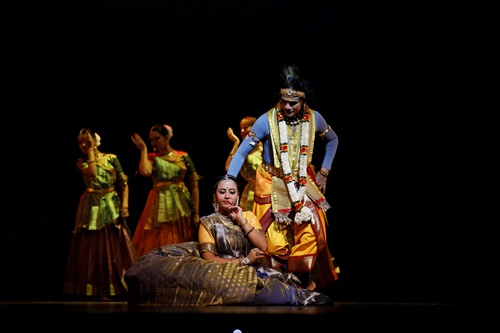
Indians are one of the four major races in Singapore, their traditional arts are well-preserved in this piece of land. A large-scale dance programme presented at The Esplanade Concert Hall in mid April, 2019 showcase in full the splendour of Classical Indian dances. Titled Natya Yatra, it was created by Singapore Indian Fine Arts Society in collaboration with The Esplanade to celebrate the society’s 70th birthday. It was also one of the programmes of its 17th Classical Indian Music and Dance Festival. Lasting 3 hours, the concert, which means journey of dance, introduced the 100 years of history of classical Indian dances with documentary, animation, narration, dance and an orchestra. The other dance groups that took part in this show are: Apsaras Art, Temple of Fine Arts, Bhaskar’s Arts Academy and Usha Rani Maniam Dance School.
There are many types of Indian dances, among which Bharatanathyam, Kuchipudi, Kathak and Kathakali are the most popular in Singapore. Because most of the Indians here are descendants of immigrants from Tamil Nadu and its surrounding regions, Bharatanathyam is the most popular art here.
The dance steps of Bharatanathyam are divided into two types: abstract movements and narrative movements. The former focus on geometric patterns while the latter seek to tell a story through facial expressions, gestures and dance steps. Guru Geethanathan, a dance teacher with SIFAS, is a graduate of Kalakshetra, a famous dance academy in India. He was one of the dancers and choreographers of Natya Yatra. He had performed in India, Malaysia, China , Japan and countries in South-east Asia. He says his involvement in Natya Yatra has helped him to understand the origins, development and future prospect of classical Indian dances here. He is pleased that the Singapore audiences truly appreciate the dances. Kuchipudi is similar to Bharathanathyam in techniques but is more folksy and sensual. SIFAS’Kuchipudi tutor Amrita Lahiri has performed abroad and observes that Singaporean students are hard-working, intelligent and passionate about classical dance. Kathak, a northern-indian dance form, stresses leaping and turning. The dancers too tell stories, among which that of Krishna is a favourite. Guru Mulla Afsar Khan who teaches Kathak at SIFAS started learning the dance with his father. He thinks that the guru is important because he can inspire the student. His colleague Aamrapali Bhandari has danced in 500 performances. She says the show has given her an opportunity to work with people from different walks of life and praises the high skill involved in the art of stage and lighting design. Kathakali originated in the South-western Indian region of Kerala. Dancers of Kathakali wear heavy and colourful makeup on their faces and splendid costumes. In Singapore, Bhaskar’s Arts Academy excels in teaching Kathakali. In March 2019, the academy staged two shows with tales taken from the Indian classics Mahabaratha. Guru Biju (47) who choreographed both shows says that Kathakali is an art which is experienced through the beautiful poetic visualisation of all the nine facial expressions.


参与大华银行广告拍摄-500x383.jpg)
